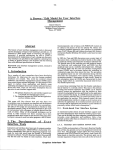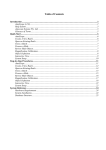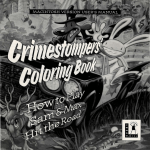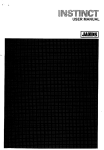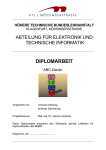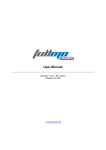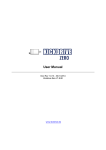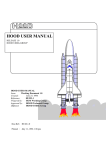Download An Editing Model for Generating Graphical User
Transcript
- 56 -
An Editing Model for Generating Graphical User Interfaces
by
Dan R. Olsen Jr.
Computer Science Department
Brigham YO\log University
Abstract
Format
A basic architecture for a User Interface Management System is
presented. The problem of updating a display in response to
interactive commands is discussed. The basic architecture is
then extended to include basic editing and browsing processes
on arbitrary data structures. Editing templates are presented as a
technique which embodies the entire manipulation process for a
particular data structure / data display combination. Such
templates in conjunction with the User Interface Management
System are able to automatically provide a majority of the code
required in an interactive application.
Introduction
Within the graphics community the concept of a User Interface
Management System (UIMS) has come into usage[TH083].
Such systems have been developed to overcome the high cost
of implementing interactive graphics programs with quality
human-computer interfaces . Most such systems have
concentrated on the problem of input dialogue management
[KAM83, GRE85 , JAC83, V AN83]. Having developed three
such systems in our laboratory[OLS83, OLS85a, OLS85b,
OLS85c], we have become concerned with the problem of data
display in an interactive program. In implementing interactive
programs we have found that the input dialogue can be
programmed in a matter of hours or days, using our tools, but
the code to update the display after each modification to the
application data structure takes months to implement.
In attacking this display update problem we approached it from
the point of view of an intelligent display processor. Our
original architecture for an interactive program is shown in
Figure 1.
Dialogue
Description
Figure 1.
In this architecture the input events are parsed according to the
dialogue description and, based on the input, one or more of
the application command procedures is invoked . It is the
responsibility of these application command procedures to
update some application data structure. It is the role of the
display processor to create a graphical presentation of the
application data according to the specified format. There are a
wide range of possible formats for displaying the data which
will only lightly be touched upon here. This architecture is
somewhat similar to that proposed at the Seeheim workshop on
user interface management [PFA85] . The key problem of
interest in this paper is how the graphical image should be
updated whenever the application data is changed. The obvious
solution is to simply redraw the entire image. This is an
extremely poor solution if one de sires reasonable respo nse
ti me.
After some experience with the above model we determined
that a closer re lationship between the data editin g commands
and the display update functions is essential. A more acceptable
sys tem architecture is shown in Figure 2.
Graphics Interface '86
Vision Interface '86
-
Formats
ard - - - i
Editing Templates
Dialogue
Description
Figure 2.
In this architecture a large portion of the interactive dialogue is
viewed as a process of browsing and/or editing the application
data structure. Based on this view, a description of the
application data is taken together with a selection of browsing
and editing methods to generate the dialogue definition, display
update procedures and application command procedures for the
selected operations. Note that this does not generate the entire
interactive program but simply the editing portion which is the
most display update intensive. Any analysis, file management
or help facilities can all be added. In our experience it is the
editing and browsing operations with dominate an interactive
program.
This paper will then proceed in the following fashion . First.a
data management facility called STUF (STrUctured Files) wIll
be reviewed so as to define the possible data structures that
might be represented in this UIMS model. This will be
followed by a short description of MIKE (Menu Interaction
Kontrol Environment) which is our input dialogue system.
Having set the stage for our editing environment, editing
templates will be described which provide the screen update
facilities that we are interested in .
STUF
The STUF package was developed as a data model specifically
for interactive applications. Our desire. was .to create a data
model which would behave equally well In mam memory or on
secondary storage. We also imposed the requirement .that
STUF data must be accessible either relation ally (as In a
relational database) or as a linked structure (as with pointers in
Pascal). The reason for this is that rela~ional ~ata models .are
very powerful but in many cases are too mefficlent for pracucal
graphics use.
Each STUF file has a specific file type which is defined by a
set of datatypes . A datatype is defined to be either a Record or
a Union. A datatype consists of a list of fields each o~ whl~h
has afieldtype. A Record is defined to have all .o f th~ flelds .m
the list. A Union is defined to have one of the fIelds m the Itst
(as determined by c: tag field at run time). ':' Union i.s si~lar in
capability to a Pascal variant record. A fleldtype IS eIther an
Integer, Real, Char, Boolean or a reference to an object of
Graphics Interface '86
67 -
some other datatype. A Field can also have dimension so as to
create fixed length arrays.
The links or references to other datatype objects pose a
problem. In a relational model, tuples are linked to each other
by matching key values . In programming languages this
linkage is handled with pointers. The pointer solution provides
the efficiency that we require but when pointers are written to
secondary storage they lose all meaning. In addition the pointer
model does not provide the flexibility found in the relational
model. The STUF solution is to create a variable length array
of tuples for each datatype in the file. A reference to a tuple is
then stored as an index into this array . New and Dispose
procedures are provided to allocate and deallocate tuples within
a data type. In adrtition, the unddeted tuples in one of the
arrays Can be treated as a relation in the sense of a relational
·d atabase to provide an associative access method for tuples.
Since tuple indices do not lose their meaning when saved to
disk or passed to another program we have our needed data
facility .
One more point to consider is that of cursors for editing. When
one is editing it is usually performed by moving some cursor or
current data object pointer. Editing and browsing operations are
then performed relative to this current data object pointer.
When editing a STUF data file, such a cursor is represented as
a tu pie index. Many of the editing templates described below
will be defined in terms of such cursors.
MIKE ,
MIKE is our dialogue handling system which is described in
more detail eliewhere [OLS85c]. The important point to
understand is how MIKE models the input dialogue. The basic
interactive unit in MIKE is the command. A MIKE command is
simply a Pascal procedure or function. MIKE accepts as its
initial dialogue description a set of such procedures and then
generates a compiled interface to these procedures. Interactively
all procedures are presented in a menu and the selected menu
item becomes the current command. Having selected a
command, MIKE then prompts with a menu of all functions
whose result type is the same as the type of the command's
first parameter. These types can be any type from the
application program. In addition to the functions in the menu,
MIKE can supply primitive inputs for integer, real, string,
function key and point types. MIKE continues accepting
inputs until a complete command expression has been parsed.
The command expression syntax is very similar to Pascal
procedure invocation syntax with the exception that no
punctuation, such as commas and parenthesis, is actually input
MIKE's interactive use of functions and procedures is similar
in many ways to Smalltalk's interactive use of methods
[GOL83] .
Given such a primitive interface, a profile editor can be used to
improve it. The profile editor allows menus to be restructured,
prompts and echos changed, icons drawn, function buttons
mapped to commands and help texts written. This fleshes out
and enhances the user's view of the interface but it does not
change the underlying model of command procedures and
functions . The profile editor serves a similar role to Buxton's
MenuLay [BUX83] in editing external presentations of
dialogues.
This command model has proven to be much simpler to use
than the state machine and grammar approaches that we have
used previously. For the purposes of our editing model of
interaction we can characterize all changes to the application
data structure as Pascal procedures or functions . That is for
each kind of change to be made to the data structure we
generate a procedure which makes the change and performs
Vision Interface '86
- 68 -
any necessary display updates. The generator then informs
of the. procedures' names and parameter types. From
thiS mformatlOn MIKE can create the necessary user input
dialogue interface.
M.IK~
Editing Templates
The editor generation concept is based on the idea of editing
templates. An editing template is designed as a presentation of a
particular general class of data structures. Linked lists, symbol
tables and trees are examples of such structure classes. An
editing template then consists of a set of routines to do the
following :
a. display application data from a STUF file using the
model,
b. provide data structure traversal commands for
browsing through the data image being displayed
by the model, and
c. provide the editing commands for creating, deleteing
and/or modifying the data presented using the
model.
It should be noted that the commands provided must in
a?dition to performing their intended tasks, also update'the
display to reflect the results of their tasks. It is the display
update which is most important to our discussion here.
In addition to the services that an editing template provides,
each template also has a set of parameters which are used when
creating an instance of a template. In this sense an editing
template can be thought of as a macro except that the
parameters may be lists and other data structures rather than
simple text to be substituted.
In SmalItalk an editing template would be defined as a class.
The services that it provides would be methods of the class and
the parameters would be methods of the objects that the
template is manipUlating. In ADA an editing template could in
most cases be represented as a generic package[GEH84] . Our
work has been done in Pascal using a macro preprocessor but
the concepts are the same. An editing template then is
characte~ize~ by the data structure that it represents . An
example IS given below of an editing template for linked lists.
Linked-List Editin& Template
As a first example of how editing templates function a linked
list is appropriate. Since an editing template is meant to be a
generic capability it must know a number of things about the
linked list that it is to display. For example it must know how
to find the head of the list, what field is used as the link for the
list, how to display one of the elements of the list and how
much display space to allocate to each element. This kind of
information is provided by the following set of parameters .
These parameters are all preceded by a percent sign so that their
text is easily recognized in the generated routines.
o/'oObjType - The data type of the list elements to be
displayed.
%Link - The field that is used to link elements of
ObjType together.
%CurObj - The tuple index variable that is to be used as
the cursor in moving up and down the linked list.
This is an index into ObjType's array.
%HeadType - The type of object where the head of the
list is stored.
%HeadField - The field in HeadType that points to the
head of the linked lists being displayed. This field
must reference data type ObjType.
%CurHeadObj - The tuple index variable that references
the HeadType tuple which contains the head of the
current list being displayed.
~ and ~ - These contain the X and Y sizes of
the screen space to be allocated to each displayed
element
%Window - This is the number of the window that the
list is to be displayed in.
%ObjOisp( ObjIndex; X,Y) - This is a routine to be
c~ed to ha:-e the list element referenced by
ObJIndex displayed on the screen at location
(X,Y).
%ObjDeJ( ObjIndex ) - This is a routine which will clean
up and delete the list element reference by
Objlndex.
%EditSpace - This is the number of list element spaces to
be left empty on the screen so that new elements
can be inserted into the list without necessitating a
repainting of the entire list.
The vari~us interac~ve tas~s that one would want to perform
on the display of a lInked list would include moving a cursor
up and down .the lis~ (scrolling the list if necessary), inserting a
new element In the list and deleting the current element from the
list In addition to these primitive operations one may also want
to select a current item from the list using some other criteria
such.as a name. Tc;> accomplish all of these the template would
prOVide the followmg command procedures directly to MIKE.
%WjndowUp
{move the list cursor up one element scrolling if
necessary }
%WjndowDown;
{ move the list cursor down one element scrolling
if necessary }
%WindowLeft and %WindowRight
{ if, because of the size and shape of the window,
the list is displayed in multiple columns then this
will move the cursor left or right as the case
may be and update %CurObj appropriately}
%WjndowPageUp and %WjndowPageDown
{ if the list is longer than will fit in the window
then this will move the cursor backward and
forward through the list one page at a time}
%WjndowDelete;
{ delete the current object pointed at by
%CurObj}
In addition to these command procedures which are exposed to
MlKE the following additional service routines are generated.
Restore%Window
{ This completely refreshs the window whenever
the window itself changes or the value of
%CurHeadObj changes . }
%WjndowUpdateCur;
{ This will simply update the display of the current
object due to some modification to it by some
other command }
%WjndowInsert( ObjIdx )
{ This will insert the specified object in to the
linked list immediately after %CurObj and make it
the current object updating the display
appropriately}
% WindowChangeCursor( ObjIdx)
{ This will change %CurObj to the value of
Objldx and update the screen appropriately}
Note that all of the names of the generated routines are
parameterized by %WjndQw so as to make them unique. Note
Graphics Interface '86
Vision Interface '86
- 69 -
also that there is no insert command exposed directly to MIKE
because of the variety of ways that an application may want to
create and initialize elements of the list. After such an element is
created by some command procedure the %WindowInsert
service procedure can be called which will handle the list
insertion and screen update tasks properly.
Note that the actual display of an element is left up to an
application supplied procedure. In many cases we have had
lists of lists to display . This is handled with two windows ,
%Wl and ~ for example. !&yu displays the main list and
can be browsed and edited as shown above. ~'s %CurObj
cursor is also the %CurHeadObj for %W2. The %ObjDisp
procedure for %Wl contains a call to Restore%W2 so that any
change of the cursor in ~ will cause an update of %W2. By
combining the linked list template with the various other
templates a large number of data display and manipulation
techniques can be implemented very quickly.
Other possibilities
The set of services provided above is not necessarily complete
nor the only possible approach. For example the linked-list
template could have a clipboard variable added as a parameter
and then supply to MIKE the necessary commands to Cut,
Paste and Copy list segments to and from the window's
clipboard. An additional feature might be an element from the
list with a mouse rather than scrolling through the list.
Other data structuring mechanisms that we have implemented
include unordered and sorted associative lists. Such lists are
a~cessed . by name or some other criteria. These two techniques
VIew a gIven STUF datatype as a table of tuples for a relation
and allow scrolling through and editing of such tables based on
application supplied sort orders and selection criteria.
These structure editing templates are being combined with a
forms editor which handles the element display functions.
Other templates which we are still working on would handle
network or schematic type displays such as is shown in Figure
3.
expressive power of both relational and linked data structures.
Display tasks are handled by formats which describe how data
shoul? appear .a~ong with editing templates which provide
genenc data edIting and screen update procedures for various
data display techniques.
The main difference between this approach and other UIMS
approaches is that the interaction is viewed as a data editing
process rather than simply as an input dialogue parsing
pr?bl~m or a screen m~nag~ment problem. Having adopted
thl.S .vIew on~ can then Id~ntify generic classes of display and
edltIng techruques for vanous data organizations. Given such a
c~ass a template is ~eveloped which carefully links the input
dIalogue WIth the dIsplay management functions to provide
vastly improved interactive response. Such a class can then be
applied to specific data editing problems simply by binding the
parameters.
Assum.ing that one has an application whose data organization
can SUItably use the editing templates provided (which is an
openended set) then an interactive browser / editor can be
created in a matter of days rather than months. For those parts
of such an application which do not match one of the existing
templates new code can be written and easily integrated with
the templates. In fact after such code has been written it should
be examined for its potential to become a new template itself.
References
[BUX83] Buxton, W. "Towards a Comprehensive User
Interface Management System." Computer Graphics 17, 3
(July 1983).
[GEH84] Gehani, N. Ada- An Advanced Introducti on.
Prentice-Hall, 1984.
[GOL83] Goldberg, A. and Robson, D. SmaJltalk-80: The
Language and its Implementation. Addison-Wesley, 1983.
[GRE85] Green, M. "The University of Alberta User Interface
Management System." Computer Graphics 19, 3 (July 1985).
[JAC83] Jacob, RJ.K. Using Formal Specifications in the
Design of a Human-Computer Interface, Communications of
the ACM 26, 4 (April 1983).
[KAM83] Kamran , A. and Feldman , M.B. "Graphics
Programming Independent of Interaction Techniques and
Styles." Computer Graphics 17, 1 (Jan 1983).
[OLS83j Olsen, D. R. and Dempsey, E. P. SYNGRAPH: A
Graphical User Interface Generator Computer Graphics 17,3
(July 83).
.
Figure 3.
Such display forms are more difficult because of the layout
connection routing aids that one would want to provide
automatically.
Summary
Our User Interface Management System therefore consists of a
command based dialogue editor called MIKE which provides
quick easily learned prototyping of dialogues along with
refinement of the dialogue via a profile editor. The interaction is
viewed as an editing of a file in STUF format which has the
Graphics Interface '86
[OLS.85a] Olsen, D.R. , Dempsey , E.P. and Rogge, R.A.
"Input/Output Linkage in a User Interface Management
System." Computer Graphics 19, 3 (July 1985).
[OLS85b] Olsen, D.R. "Pushdown Automata for User
Interface Management." ACM Transactions on GraphicS 3, 3 _
(July 1985).
[OLS85cj Olsen, D.R. "User's Manual for MIKE-2.0." Tech .
Report 85-1, Computer Science Department, Brigham Young
University, Provo, UT.
[PFA85] Pfaff, G. and ten Hagan, P.J.W. Seeheim
Workshop on User Interface Management Systems.
Springer-Verlag, Berlin, 1985.
Vision Interface 'S6
- 70 -
[TH0 83] Thomas , J. J. and Hamlin, G. Graphical Input
Interaction TechniQue Workshop Summary, Computer
Graphics 17, 1 (Jan . 1983).
[V AN83] van den Bos, 1., Plasmeijer, MJ. and Hartel, P.H.
"Input-Output Tools: A Language Facility for Interactive and
Real-Time Systems." IEEE Trans actions on Software
Eneineerine SE-9, 3 (May 1983).
Graphics Interface '86
Vision Interface '86





